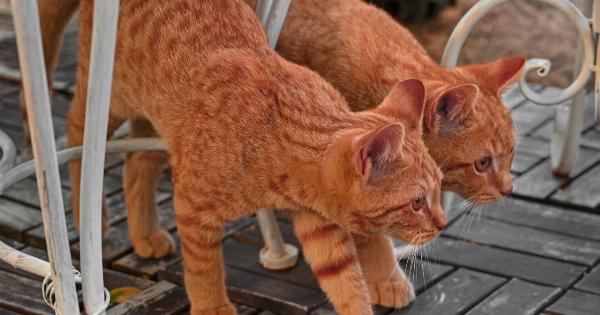Cats are unique creatures with incredible sensory abilities that allow them to navigate and interact with their environment in fascinating ways. Each of their senses is finely tuned to help them survive and prosper in the wild.
From their acute hearing to their remarkable night vision, cats possess an array of remarkable senses that contribute to their mysterious and captivating nature.
1. Sight
One of the most striking features of cats is their captivating eyes. Cats have excellent vision, which is specially adapted for their nocturnal hunting habits. Their eyes have a large cornea and iris, allowing more light to enter the eye.
Additionally, the retinas of cats contain a higher density of rod cells, specialized for low-light vision.
Cats also possess a reflective layer behind their retina called the tapetum lucidum, which enhances their night vision.
This reflective layer bounces light back through the retina, giving their eyes a distinctive glow when light shines on them in the dark.
2. Hearing
Cats have highly developed hearing abilities that far surpass those of humans. They can hear a wide range of frequencies, including ultrasonic sounds that are inaudible to humans.
This exceptional hearing is essential for their hunting skills as they can detect the squeaks and movements of their prey.
One remarkable feature of a cat’s hearing is their ability to rotate their ears independently. This allows them to pinpoint the exact location of a sound source with great precision.
They can also move their ears like radar dishes, swiveling to catch even the faintest of sounds.
3. Smell
A cat’s sense of smell is much stronger and more sensitive than that of humans. Cats possess a specialized organ, called the Jacobson’s organ, located in the roof of their mouth.
This organ allows them to “taste” smells by opening their mouth slightly and inhaling deeply. It helps them detect pheromones, which play a crucial role in communication with other cats.
Their extraordinary sense of smell also aids in hunting, as they can detect scents left behind by their prey or potential predators. Cats can even recognize the scent of their owners, further enhancing their bond with humans.
4. Taste
Cats have a highly developed sense of taste, albeit with some unique preferences compared to humans. They have fewer taste buds for sweetness than humans do, which is why they are not particularly fond of sweet treats.
Instead, they have a preference for foods with strong aromas and flavors, such as fish.
Cats are considered obligate carnivores, meaning that their diet primarily consists of meat. Their taste buds are finely tuned to detect the savory and umami flavors found in animal proteins, making them less receptive to other tastes.
5. Touch
Their whiskers, known as vibrissae, play a crucial role in a cat’s sense of touch. Whiskers are highly sensitive and help cats navigate their environment by detecting changes in air currents.
They provide cats with information about the size, shape, and movement of objects around them. Whiskers on the back of the forelegs also help them judge whether they can fit through a narrow space.
Cats have specialized nerve endings in their skin, making them highly sensitive to touch. This sensitivity allows them to feel even subtle vibrations, making them excellent hunters.
They can also interpret touch to communicate, such as gentle head bumps or kneading with their paws to show affection.
6. Balance and Orientation
Cats have a remarkable sense of balance and orientation, thanks to their inner ear. The inner ear serves as their vestibular system, which detects changes in motion and helps them maintain balance.
This adaptability is what enables cats to land gracefully on their feet, even when they fall from significant heights.
Their flexible spine and collarbone-free shoulder blades further enhance their agility and allow them to twist and rotate their bodies mid-air. This remarkable acrobatic ability is a testament to their extraordinary sense of balance.
7. Time Perception
Cats have a unique sense of time perception that differs from humans. They are crepuscular animals, meaning they are most active during dawn and dusk.
Due to their ancestral hunting patterns, their internal clock is attuned to these periods, making them more alert and energetic during these times of the day.
Furthermore, cats have an uncanny ability to anticipate events, such as mealtime or their owner’s arrival, through their sense of time.
Their internal clock helps them establish routines and develop a strong sense of predictability in their daily lives.
8. Sensitivity to Vibrations
Cats are incredibly sensitive to vibrations in their environment. Their paws are equipped with specialized receptors that detect subtle vibrations in the ground.
This ability aids in hunting as it allows them to detect the movement of their prey even when out of sight.
Additionally, some studies suggest that cats can perceive seismic activity before humans. They may sense vibrations or changes in air pressure that occur before an earthquake, making them valuable “earthquake detectors” in some regions.
9. Extraordinary Spatial Awareness
Cats have an innate ability to navigate through tight spaces with incredible precision. Their excellent spatial awareness is attributed to their highly developed senses, particularly touch and whisker sensitivity.
They can weave through narrow gaps, jump from one surface to another with pinpoint accuracy, and even squeeze into tiny boxes.
Their flexible bodies and acute awareness of their surroundings allow them to explore and conquer their environment with ease.
10. Sixth Sense?
While not scientifically proven, many cat owners believe that cats possess a sixth sense or an extrasensory perception.
Cats have been observed displaying unusual behavior before natural disasters or sensing the presence of certain illnesses in their human companions.
Although it remains a mystery, this alleged sixth sense adds to the mystical allure of cats and has fascinated humans throughout history.






























